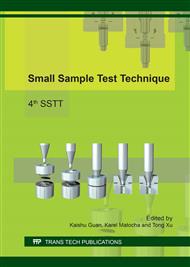p.144
p.159
p.168
p.176
p.185
p.194
p.202
p.206
p.212
Development of Fatigue Testing Machine for Small Sized Specimen in Liquid Environment
Abstract:
This paper describes the development of a fatigue testing machine for small sized specimens in liquid environment. Since this type of testing machine is not available commercially, it has been designed, developed and built without any reference machine. The machine can operate tests on specimens with the shape of a solid cylinder with a diameter of 2 mm, a gage length of 4 mm and a total length of 34 mm. The testing machine consists of a testing stand, an environment vessel, a liquid cooling system and a test control system. Since the machine operates with combustible liquids, some safety devices have been also installed to prevent the machine from fire and explosion. The tests made for measuring the performance of the machine have been conducted on a specimen made by 440 stainless steel. The maximum applicable frequency by the testing machine is 100 Hz but only in a range of applied stress amplitude from 0 to 800 MPa. In 800 – 1200 MPa, the maximum frequency decreases down to 50 Hz with increase in the stress amplitude.
Info:
Periodical:
Pages:
185-193
Citation:
Online since:
April 2017
Authors:
Price:
Сopyright:
© 2017 Trans Tech Publications Ltd. All Rights Reserved
Share:
Citation:


